| Pages:
1
..
60
61
62
63
64
..
66 |
blogfast25
International Hazard
    
Posts: 10562
Registered: 3-2-2008
Location: Neverland
Member Is Offline
Mood: No Mood
|
|
I'm afraid the unsaturation might metallate with K.
|
|
|
Etaoin Shrdlu
National Hazard
   
Posts: 724
Registered: 25-12-2013
Location: Wisconsin
Member Is Offline
Mood: Insufferable
|
|
I wasn't expecting any difficulty because dissolving metal reductions leave alkenes as they are, but that's a much different solvent of course...
EDIT: This article indicates you would need a superbase for that to happen but I haven't been able to find much. http://pubs.acs.org/doi/abs/10.1021/jo00126a074
[Edited on 1-11-2016 by Etaoin Shrdlu]
|
|
|
NeonPulse
Hazard to Others
  
Posts: 417
Registered: 29-6-2013
Location: The other end of the internet.
Member Is Offline
Mood: Isolated from Reality! For Real this time....
|
|
Has anybody here had successfully made K metal using them supposed Mg fire starter blocks? The reason I ask is I have tried several times using this
to no avail. Some very small amounts form at the start of the reaction-1 hour refluxing and disappear some time later. I followed woeleon pages
procedure exept using mineral oil instead of THN. I had today only received my 99.9% ingots of Mg to try and these blocks feel a bit more dense than
the fire starter blocks so perhaps they are magnalium instead. And after reading a majority of this thread it does look like other people have also
tried these blocks without success. I feel confident that I can master this reaction in the next couple of goes.I've tried 6 times previously with the
blocks and cut up Mg ribbon which was slightly oxidised with lamp oil and with mineral oil and adding catalyst all at once and staggered like most of
the synthesis methods I've read suggest to do. I'm sure there fire starter blocks are the problem.
|
|
|
blogfast25
International Hazard
    
Posts: 10562
Registered: 3-2-2008
Location: Neverland
Member Is Offline
Mood: No Mood
|
|
Quote: Originally posted by NeonPulse  | | I had today only received my 99.9% ingots of Mg to try and these blocks feel a bit more dense than the fire starter blocks so perhaps they are
magnalium instead. |
It's unlikely to be MgAl. Do test though: density will tell you what's what: Mg = 1.74, Al = 2.7.
|
|
|
NeonPulse
Hazard to Others
  
Posts: 417
Registered: 29-6-2013
Location: The other end of the internet.
Member Is Offline
Mood: Isolated from Reality! For Real this time....
|
|
Ok so tried again to get elemental K with a half success. k was formed but it is in the fines at the bottom of the flask and I can't seem to make it
into balls. Is there some trick to this? My process was as follows:
3.5g Mg metal powder made by taking a rotary burr to the ingot and the metal further ground in a coffee grinder. 7g KOH in 40ml if quality lamp oil.
Ito a 100ml Erlenmeyer flask with a Liebig condenser attached and cool air fed into this.
So I heated the sand bath and got the temp to 100 c and white fumes started to come off the oil with some flashes and the hydroxide seems to fluff
up.I keep the heating to 220 c And Tested liquid with a mercury thermometer, so I add the first portion of 2ml tert butanol mixed with the solvent
and every 10 mins after totalling 0.8ml alcohol. The flask was swirled occasionally and left to reflux for the 4 hours. I tested some of the fine
material and this definitely sparked in water so K is present. If I left it longer maybe the fines will coalesce.
the big white bits are un reacted KOH and still spark a little but that's probably just fines adhering to them. I'm not sure what I can do now since
I've tried 8 times now to make K! There's an empty ampoule waiting for it in my element collection. I must be doing something wrong or this is a
finicky reaction where the slightest things will alter the results. I'm going to remove the unreacted stuff, decant the solvent and put in fresh oil
and heat to attempt to coalesce the fine sandy material- unless it would be a waste of time.
[Edited on 15-1-2016 by NeonPulse]
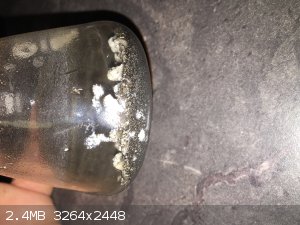 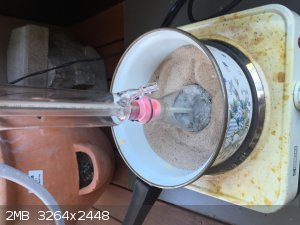
[Edited on 15-1-2016 by NeonPulse]
|
|
|
blogfast25
International Hazard
    
Posts: 10562
Registered: 3-2-2008
Location: Neverland
Member Is Offline
Mood: No Mood
|
|
Try coalescing the K at a lower T: no more than 100 C.
|
|
|
MrHomeScientist
International Hazard
    
Posts: 1806
Registered: 24-10-2010
Location: Flerovium
Member Is Offline
Mood: No Mood
|
|
There's currently an eBayer selling Tetralin: http://www.ebay.com/itm/221631339997
You may recall this as the solvent Nurdrage used in his potassium synthesis, the main benefit of which is its density. It is more dense than
potassium, meaning the metal produced in the reaction floats and coalesces more easily.
I purchased 600mL today, but delivery to me will take about a month according to eBay. I'll keep you all posted.
|
|
|
blogfast25
International Hazard
    
Posts: 10562
Registered: 3-2-2008
Location: Neverland
Member Is Offline
Mood: No Mood
|
|
Please do.
|
|
|
NeonPulse
Hazard to Others
  
Posts: 417
Registered: 29-6-2013
Location: The other end of the internet.
Member Is Offline
Mood: Isolated from Reality! For Real this time....
|
|
I can field that question m. This supplier although slightly expensive is reputable. I had my 300ml tertralin order arrived a couple days ago. It was
well packaged in a HDPE bottle and further sealed in heavy plastic bag. It sure stinks like tetralin. I've also had other orders in the past from this
seller and haven't had a problem. I haven't had time to test it yet but I also got some reagent KOH and in the next week or so I should have the time
to try again, and it's gotta work this time, I'm sooo close. I'll be sure to report on my next attempt. I couldn't get the K Particles to
coalesce last time and got the shits and ordered the tetralin.
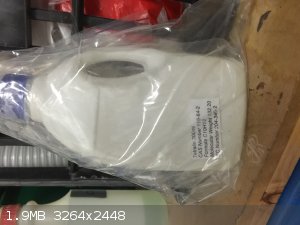
[Edited on 10-2-2016 by NeonPulse]
|
|
|
NeonPulse
Hazard to Others
  
Posts: 417
Registered: 29-6-2013
Location: The other end of the internet.
Member Is Offline
Mood: Isolated from Reality! For Real this time....
|
|
OK, it has been a couple of weeks since i received the tetralin and sadly i have had no success with it. With each reaction i have used the same
amount of KOH and Mg and catalyst. for the tetralin runs {3} i used the nurdrage video proportions. I have run this reaction around 15 times now and
only had a dark sandy material which i suspect is fine K. no blobs. some of the reaction mixtures have reacted well with water sparking and leaving
the burnt metal smell. i have tried paraffin oil of the type used as a laxative from a pharmacy-two different brands, quality clear lamp oil, a
thinner paraffin- "diggers" brand from the hardware store and now tetralin. i have tried Mg from firestarter blocks and 99.9% Mg in an ingot from an
Ebay seller and Mg ribbon which i had painstakingly scraped the oxide off of and cut into thin strips and squares. The Mg particles have been drill
turnings from large and small bits and further refined in a coffee grinder and a fine carbide burr to shave fine fluffy powdery flakes. The
Temperature of the runs has been consistently around 200/230C. The speed at which i ramp up the temperature has been around 30mins or so until i can
add the alcohol. I have had a scary experience once with hydrogen popping and this scared the shit out of me, i removed the condenser to vent gasses
and there was a huge pop. scared the shit out of me. 3 other times where there was Mg/KOH burning inside the flask that quickly extinguished itself
Also I have tried 3 different KOH types- some flakes that were A.R grade of which i had enough for two runs-they were quite translucent, and some
visibly lower quality soap makers flakes- these were more white. Blaming my failures on this i got some high quality A.R grade KOH pellets. The
T-Butanol was from IslandScents and Scentsability, Which i see elsewhere in this thread has worked for others. It has the correct melting/freezing
point, smell and is what it says it is. i can't find any T-amyl alcohol at a reasonable price for a small amount else i would try it.
Im at a loss. strangely withthe tetralin the runs have turned blue. firstly after refluxing for an hour or so a brownish colour then after a couple of
hours a lavender and by the end of the 3rd hour it was quite blue. strange. could it be solvated K? No metallic K though- not one bit. the KOH fizzed
when the reaction was scooped into water but that's all.
I am beginning to lose patience with this. but i have invested so much time now it would be silly to quit. i want to have a success.
Another thought that could be contributing was Although the Burred off filings and some drilled bits are fresh surfaces they do seem silvery but also
dull and not shiny and could be due to the heat generated from friction. of drilling/rasping them. they do go straight into a sealed bag and then the
oil within 10 mins of filing them.
i note that in some of the reactions the Mg metal looks like it is getting oxidized/passivated and does not get consumed. is this effect from the sand
bath heat? can you run this too hot? no signs of K were seen in these runs.
All of my runs were done in a flat bottomed erlenmeyer 100mls and 50mls for the tetralin runs all with a liebig condenser cooled with an air pump and
in a sand bath. There has to be a reason it is not working for me. i have got some more MG on order from naother supplier
Oh and i also made an attempt using Calcium metal shaving/drill turnings and with no success. they possibly got too oxidised before i got them in the
mineral oil due to the humidity of where i live but most of them were shiny still. did a run of four hours. i think i used 2.5g Ca metal in 40ml oil.
i wrote down the amount of KOH and other temperature details/observations i used but i cannot find the page right now.it was just like a normal run
with the Mg. There was nothing that stood out i can remember but unlike when the Mg gets to around 100C there is white fumes that fill the vessel but
there was none with calcium.
The pictures are from a tetralin run and there are two from the calcium run.
Any pointers? i am highly annoyed at this process but there has to be a solution. Maybe attempting to dry the KOH in an oven or something or using I2
to "activate" the Mg. whatever.
http://illumina-chemie.de/darstellung-von-metallischem-kaliu...
so i just translated this page and saw that the MG metal has been added in two portions- i am yet to try this approach. Has anybody else has success
using this method?
[Edited on 21-2-2016 by NeonPulse]
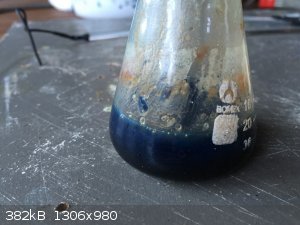 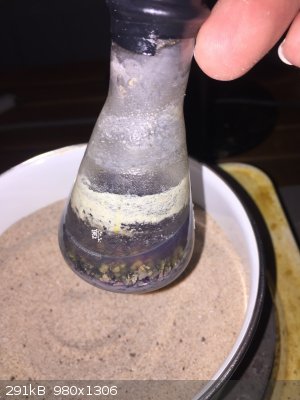 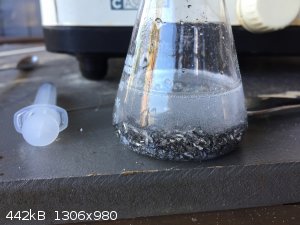 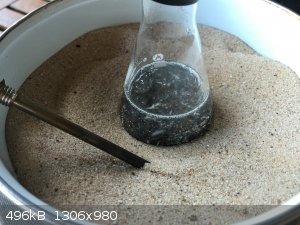
[Edited on 21-2-2016 by NeonPulse]
|
|
|
blogfast25
International Hazard
    
Posts: 10562
Registered: 3-2-2008
Location: Neverland
Member Is Offline
Mood: No Mood
|
|
@NeonPulse:
Very frustrating, indeed. I can't see what you're doing wrong.
Do try this (works for me): add all the alcohol right from the start with the other ingredients, then start heating. Slowly at first until you have
the hydrogen surge, then take it to BP (200 - 220 C).
NEVER 'vent': all hydrogen escapes through the top of the refluxer. Oxygen is the enemy here!
|
|
|
wg48
National Hazard
   
Posts: 821
Registered: 21-11-2015
Member Is Offline
Mood: No Mood
|
|
Direct attempt to produce a K/Na alloy
I wanted to try the low temperature reduction of hydroxide with magnesium using the catalyst method. But did not have the catalyst so I decided to try
a direct reduction. I used a eutectic of 50:50 by mass of KOH and NaOH so I could use a temperature of about 170C and hopefully produce a room
temperature molten alloy of K/Na. The idea was that would simply the separation from the unwanted reaction products. I know the alloy is very
reactive.
An initial experiment using an open stainless steel (SS) dish indicated the magnesium does react with the molten eutectic and not too violently if
added in small additions.
I used the apparatus shown below. Consisting of a small SS pot with a lid. An aluminium tube supplied a flow of butane from a small butane torch to
provide an inert blanket to prevent oxidation of the K/Na. The escaping butane was ignited and formed a flame as seen in the pic. The magnesium powder
was dropped through the flame untill no more reaction occurred as indicated by the flame flarring up. The apparatus was then left to cool with the
butane following. The contents was them flooded with mineral oil.
On inspection of the cooled contents of the pot it contained an off white foamed hard solid but no alkali metal was visible. The oil was removed and
water was added. No fizzing but the water boiled at the surface of the solid but no vapour reached the surface. Eventually the solid dissolved in the
water and white precipitate formed.
I suspect that the butane flame drew in air past the lid that burnt any formed alkali metal.
An other attempt will need a better apparatus with a sealed lid and a better method of adding the magnesium. Probably magnesium ribbon would be
ideal.
At best the yield is likely to be in the 25% percent range because the magnesium oxide/hydroxide formed in the reaction thickens /solidifies with K/Na
hydroxide preventing reaction with the magnesium.
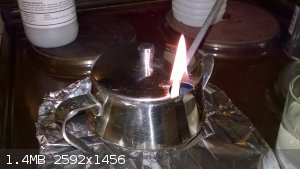
|
|
|
blogfast25
International Hazard
    
Posts: 10562
Registered: 3-2-2008
Location: Neverland
Member Is Offline
Mood: No Mood
|
|
Interesting experiment.
That Mg reduces KOH/NaOh we also know from various thermite style attempts and that:
KOH + Mg ===> K + MgO +1/2 H2
...has a ΔH<sup>0</sup> = - 176 kJ/mol.
Bear also in mind that your NaOH/KOH contains some water, as all grades of KOH do.
I think you'll need a slightly better reactor and preferably using argon:
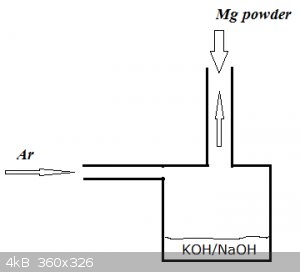
|
|
|
NeonPulse
Hazard to Others
  
Posts: 417
Registered: 29-6-2013
Location: The other end of the internet.
Member Is Offline
Mood: Isolated from Reality! For Real this time....
|
|
Finally!
Well it was about goddamn time! Finally I can report a success! The reaction is cooking away as I type but it is looking good! There are many small
balls of K floating atop the reaction mixture finally! There are three things I have done different. After reviewing the verschemie K preparation I
decided to try the following:
1. The Mg was added in two portions. 1.5g firstly and After the initial gassing off had settled the remaining 2.5g were added. Temp was 180c at this
point.
2. The catalyst was added all at once just after the 2nd Mg portion. I have tried this approach before but with no success.
3. The grade of Mg: I got out my reciprocating saw with the metal cutting blade put the ingot in the vise and had a bag around it to collect the
metal. Depending how hard I pressed on the saw I got a mixture of fine and coarser particles. I had not ever done it this way. There was a mixture of
fine powder and coarser powder but still finer than I had used previously. I also used the diggers brand parrafin oil. It's looking good after around
15 attempts I very nearly gave up. I am going to try this approach with tetralin as the solvent in the near future. Probably a small batch though. One
step closer.
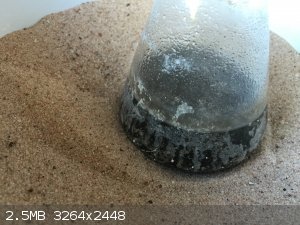 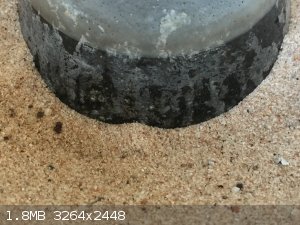
[Edited on 28-2-2016 by NeonPulse]
|
|
|
elementcollector1
International Hazard
    
Posts: 2684
Registered: 28-12-2011
Location: The Known Universe
Member Is Offline
Mood: Molten
|
|
How 'fresh' was the Mg you were using before? Typically, it's recommended that one start with freshly cut Mg so that it remains 'activated'.
Glad to see you succeeded!
Elements Collected:52/87
Latest Acquired: Cl
Next in Line: Nd
|
|
|
blogfast25
International Hazard
    
Posts: 10562
Registered: 3-2-2008
Location: Neverland
Member Is Offline
Mood: No Mood
|
|
@NeonPulse:
Glad to hear it!
|
|
|
MrHomeScientist
International Hazard
    
Posts: 1806
Registered: 24-10-2010
Location: Flerovium
Member Is Offline
Mood: No Mood
|
|
Well I got my tetralin in the mail and attempted the reaction today, but my hotplate never got over 160C for some reason and no reaction occurred.
Some bubbling did happen near 100C, which was undoubtedly water escaping.
Mostly I wanted to report my conclusion that tetralin is NOT something I want to work with without a fume hood. I did the reaction outside with a big
fan blowing across the apparatus, but the smell of tetralin is very strong and pungent. I would do some work, walk to fresh air, breathe for a minute,
then return and repeat, but even so I felt light headed and somewhat nauseous during setup and breakdown. Resting and plenty of water is helping. I'm
going to put the breaks on this reaction for now until I get a working fume hood. This stuff just makes me too uncomfortable being around unprotected.
I've sealed the bottle of tetralin in a bucket for now.
|
|
|
blogfast25
International Hazard
    
Posts: 10562
Registered: 3-2-2008
Location: Neverland
Member Is Offline
Mood: No Mood
|
|
Quote: Originally posted by MrHomeScientist  | Well I got my tetralin in the mail and attempted the reaction today, but my hotplate never got over 160C for some reason and no reaction occurred.
Some bubbling did happen near 100C, which was undoubtedly water escaping.
Mostly I wanted to report my conclusion that tetralin is NOT something I want to work with without a fume hood. I did the reaction outside with a big
fan blowing across the apparatus, but the smell of tetralin is very strong and pungent. I would do some work, walk to fresh air, breathe for a minute,
then return and repeat, but even so I felt light headed and somewhat nauseous during setup and breakdown. |
160 C is far too low. It takes at least 1 to 1 1/2 hour to complete reaction at 200+ C, then some more to coalesce the K.
Hood or not, you have to use an effective air-cooled refluxer. You'll lose the catalyst if you don't anyway.
With a decent refluxer you won't even get a whiff of the solvent, I guarantee you that.
[Edited on 29-2-2016 by blogfast25]
|
|
|
Tdep
National Hazard
   
Posts: 516
Registered: 31-1-2013
Location: Laser broken since Feb 2020 lol
Member Is Offline
Mood: PhD is done! It isn't good but it's over lol
|
|
Yeah I second blogfast, I run a water cooled condenser (at least I think I ran water through it..? I might have just had the condenser there, but
fairly sure I ran water with no issues) and tetralin and there's no smell at all, let alone an unpleasant one.
|
|
|
MrHomeScientist
International Hazard
    
Posts: 1806
Registered: 24-10-2010
Location: Flerovium
Member Is Offline
Mood: No Mood
|
|
Well sure, I didn't expect anything to happen at 160C. Mainly I wanted to report on the tetralin business. My setup is as it was before, with a 100mL
round bottom flask connected to a Liebig condenser open to the air (no water, and no pumping air). This worked fine in my original experiments.
The problem isn't during reflux. I smelled nothing at all during the run. The problem is in setup and break down, when open bottles and apparatus
release fumes all over the place. That's unavoidable.
|
|
|
blogfast25
International Hazard
    
Posts: 10562
Registered: 3-2-2008
Location: Neverland
Member Is Offline
Mood: No Mood
|
|
Understood.
|
|
|
NeonPulse
Hazard to Others
  
Posts: 417
Registered: 29-6-2013
Location: The other end of the internet.
Member Is Offline
Mood: Isolated from Reality! For Real this time....
|
|
I agree that the tetralin reeks but you can't smell it until you break open the vessel for cleanup.
It is pretty disgusting smelling stuff and suspected to cause cancer. Anyways another successful reaction this time with tetralin. I followed
nurdrage's procedure but adding the Mg in two portions 1g and 1.4 g after the initial hydrogen evolution at around 160c. Also I added the t- butanol
in one gulp using excess totalling 1.3ml. Checking the reaction after 1.5 hours I could clearly see the telltale shine if floating K. Some large
blobs which had joined into one large sphere. I'm cooling it as I type and will weigh it and report. It seems like the adding the Mg in portions after
the gasses slow evolution is a winner. I only wish I translated that page earlier and save the trouble I had.
The first reaction in paraffin I did actually grew a whole lot of tiny spheres which were difficult to collect so not many larger bits were collected
and they would not coalesce either.
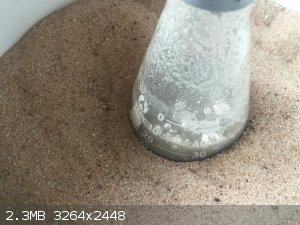 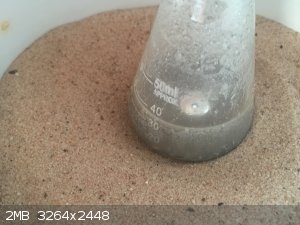
|
|
|
Pok
potassium Prometheus
  
Posts: 176
Registered: 5-12-2010
Member Is Offline
|
|
I don't think that this is the key. There are many examples which add the Mg in one portion at the beginning and are equally successful. I made it
several times in both variations and the success was absolutely independent of this procedure. This wasn't the only difference to your unsuccessful
tries. You also made the Mg powder in a different way.
Most problems seem to arise from "inactive" Mg powder. I have done it with several Mg sources. New and shiny always works, but older Mg powder never
worked. Also, newly bought Mg powder always worked after I bought it and a few months later it never worked again with that powder (stored in a
plastic bag where air and humidity are not fully excluded). Up to now, nobody seems to have managed it to "activate" oxidized Mg so that it is
suitable for this reaction. Iodine doesn't seem to work. It's not a good solution if one has to use newly bought / fresh Mg powder or file it off a
block by oneself. I think it would be very useful to find a way how to regenerate old Mg powder in a comfortable way.
|
|
|
MrHomeScientist
International Hazard
    
Posts: 1806
Registered: 24-10-2010
Location: Flerovium
Member Is Offline
Mood: No Mood
|
|
That's great work NeonPulse, and confirms my suspicions about my own reaction conditions. I used lamp oil and got potassium sand, but was never able
to coalesce during the reaction. The tetralin helps by allowing the K to float and come together much easier. I really can't wait to get this done.
Did you use a fume hood when working with your tetralin? If not how did you minimize fume exposure?
|
|
|
blogfast25
International Hazard
    
Posts: 10562
Registered: 3-2-2008
Location: Neverland
Member Is Offline
Mood: No Mood
|
|
MrHomeScience:
IIRW, with tetralin 'nurdrage' got the whole job done (coalescence included) in about an hour, so it will be very interesting to see how it works out
for you.
|
|
|
| Pages:
1
..
60
61
62
63
64
..
66 |